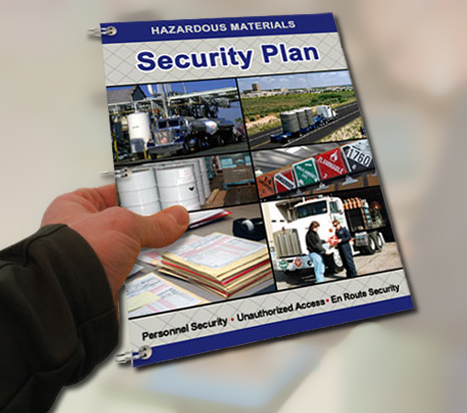Are You Safe???
Just wanted to get your attention!

Does your company have a Hazardous Materials Transportation Security Plan…or do you even know if you are required to have one?
The Department of Transportation (DOT) requires any person who offers or transports certain types of hazardous materials to prepare and follow a security plan. First, what is an “Offeror” and what is a “Transporter”?
An “offeror” is defined by the DOT in 49 CFR 171.8 as any person who does either or both of the following:
- Performs, or is responsible for performing any pre-transportation function required under this subchapter for transportation of the hazardous material in commerce.
- Tenders or makes the hazardous material available to a carrier for transportation in commerce.
A “carrier” is not an “offerer” when it performs a function required by this subchapter as a condition of acceptance of a hazardous material for transportation in commerce (e.g., reviewing shipping papers, examining packages to ensure that they are in conformance with this subchapter, or preparing shipping documentation for its own use) or when it transfers a hazardous material to another carrier for continued transportation in commerce without performing a pre-transportation function.
A “transporter” is defined by the DOT in 49 CFR 171.8 as:
- Transportation or transport means the movement of property and loading, unloading, or storage incidental to that movement.
- Movement means the physical transfer of a hazardous material from one geographic location to another by rail car, aircraft, motor vehicle or vessel.
OK…so far, so good! The “offerer” gives the hazardous material to the “transporter” and the “transporter” actually moves the material to its destination.
So, what types of hazardous materials trigger the security plan requirement?
Well, the DOT (in 49 CFR 172.800) identifies any person who offers for transportation in commerce or transports in commerce, one or more of the following materials as being required to develop and follow the security plan.
- Any quantity of a Division 1.1, 1.2, or 1.3 material;
- A quantity of a Division 1.4, 1.5, or 1.6 material requiring placarding in accordance with subpart F of this part;
- A large bulk quantity of Division 2.1 material;
- A large bulk quantity of Division 2.2 material with a subsidiary hazard of 5.1;
- Any quantity of a material poisonous by inhalation, as defined in §171.8 of this subchapter;
- A large bulk quantity of a Class 3 material meeting the criteria for Packing Group I or II;
- A quantity of desensitized explosives meeting the definition of Division 4.1 or Class 3 material requiring placarding in accordance with subpart F of this part;
- A large bulk quantity of a Division 4.2 material meeting the criteria for Packing Group I or II;
- A quantity of a Division 4.3 material requiring placarding in accordance with subpart F of this part;
- A large bulk quantity of a Division 5.1 material in Packing Groups 1 and II; perchlorates; or ammonium nitrate, ammonium nitrate fertilizers, or ammonium nitrate emulsions, suspensions, or gels;
- Any quantity of organic peroxide, Type B, liquid or solid, temperature controlled;
- A large bulk quantity of Division 6.1 material (for a material poisonous by inhalation, see paragraph (5) above);
- A select agent or toxin regulated by the Centers for Disease Control and Prevention under 42 CFR part 73 or the United States Department of Agriculture under 9 CFR part 121;
- A quantity of uranium hexafluoride requiring placarding under §172.505(b);
- International Atomic Energy Agency (IAEA) Code of Conduct Category 1 and 2 materials including Highway Route Controlled quantities as defined in 49 CFR 173.403 or known radionuclides in forms listed as RAM-QC by the Nuclear Regulatory Commission;
- A large bulk quantity of Class 8 material meeting the criteria for Packing Group I.
Notice that most of the items identified are shipments that would require a placard. So, if you ever offer a transporter a shipment that requires the transporter to place a placard on the truck, you should look at the requirements for the Hazardous Materials Transportation Security Plan. If you are required to develop and follow a security plan, you will need to conduct risk assessments and identify possible mitigation practices in the following areas; personnel security, unauthorized access, and en route security.
There are additional requirements and the DOT has available a free guidance document here.
Of course…INGENIUM is ALWAYS here to help.
